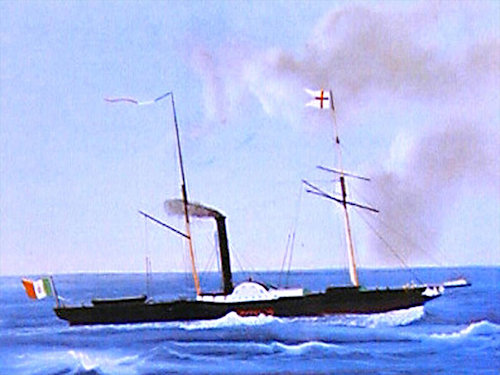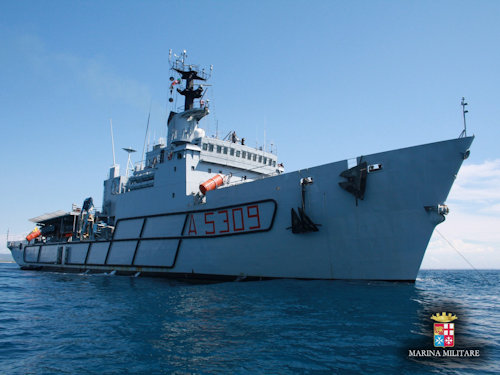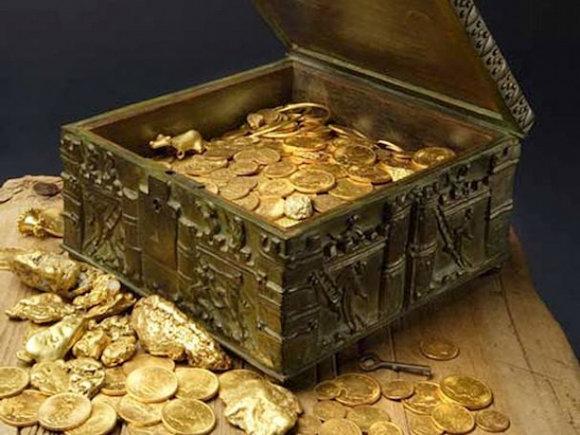Emeralds, diamonds, jewelry, watches, thousands of gold and silver coins. A real treasure hidden in the backdrops of the Tuscan Archipelago. It is the gold of the Elbe. An invaluable treasure: almost 350 millions of euros, experts suggest. The night of 17 June 1841 the steamer Pollux she dived off the island of Elba, spurred on by another ship, carrying a mysterious load of precious coins and jewels. Probably because of an attempted take-over to steal the precious cargo that he carried.
The pironaviglio Pollux built in the 1839 by Le Havre Normandy yards and purchased by the De Luchi-Rubattino shipping company founded in 1838, together with the twin unit Castor. He owned a steam engine built in England; produced a power of 160 CV that moved the two side-bladed wheels capable of reaching the ship at a speed of 10 knots. The transfer to the port of Genoa was carried out on 13 April 1841 and from here started its regular line Marseilles - Genoa - Livorno - Civitavecchia - Naples. At 23,45 of the 17 June 1841 the Pollux he was rammed by the steamer Mongibello, near the island of Elba at about 2,9 km from Capo Calvo. The Neapolitan ship Mongibello, then Monzambano, the first Italian hydrographic ship after national unity; with this sinking he found himself at the center of a story that was as mysterious as it was fascinating from the possible political implications of considerable historical importance.
People aboard, about 80 between passengers and crew, managed to save themselves. The methods of the incident lead to the suspicion that the Neapolitan ship has been voluntary, and recent historical research led to the idea that the Pollux he had something on board that did not have to come to Genoa, perhaps financial aid provided by the British to the Italian patriots. The Rubattino (1810-1881), assisted by the lawyer Guerrazzi patriot livornese, intented the Neapolitans, and also won the trial, which took place in Livorno in 1842, but was never compensated, as did no compensation for passengers because the ship was not insured and the law of time did not cover such claims at sea. The shipowner Rubattino, two months later, desperately tried to recover the wreckage and the cargo, a bold undertaking for the times. He tied the wreck with the chains and began to pull it up with 11 ships, but the attempt failed due to the breakup of a chain.

The details of the failed recovery are known through a 48 page booklet, published just one week after the failed attempt in November 1841 by Neapelian colonel of Cesar de Laugier but elbasan birth. Subsequently, a Livornese society sought to locate the wreck without results, the same was done by the Ministry of War of Paris. In the 1920s, the mayor of the island of Elba, Bertolini, repeatedly sought to locate him. Only in the 1936 the So.Ri.Ma. (Maritime Recovery Company) of Genoa (founded in 1926 by commendatore Giovanni Quaglia, forerunner of all modern deep-sea shipwreck and underwater operations with three ships: Claw, Rostrum, Harpoon to which they are added later Raffio, Rampino, Rake), who probably located the wreck but had to abandon the checks due to an urgent work in Sardinia. When the landowners of So.ri.ma left the bay of Porto Azzurro del Pollux only the legend remained.
The acts of the Livorno process have, however, remained strange until, as is well known, they would be scanned and copied by a Frenchman who would sell them to an English company. In the 2000 of the British through the British consulate in Florence asking permission to recover the aluminum load of Glenlogan, an English ship sunk in the 1916 by a German U-boot, lying in the depths at Stromboli, but entering the coordinates of the wreck of the Pollux. No one noticed during the bureaucratic path of this insertion, giving him permission. After renting a tug in Genoa, where a crane had been installed, the recovery operations began, by randomly pulling at least three tons of debris at the bucket, sipping the material in search of precious. After 21 days, the British group resumed with the booty, later estimated at around one and a half million Euros (gold and silver coins, jewelery of the early nineteenth century, pots, glasses and clocks). At the Italian Harbor Master's Office they claimed to have found the British ship they were looking for, and they had recovered some precious and some material. It is different from the version given to the British authorities, which they claim to have found material, but on a sunken ship in international waters (a circumstance that guarantees the property of recovery if no one gets right). Following a survey carried out by the Carabinieri Patrimonio Culturale di Firenze, the 10 October 2002, Scotland Yard delivered what they had been kidnapped on 17 June 2001 at the London auction house Dix Noonan Webb. The act of vandalism carried out by these treasure hunters severely affected the integrity of the wreckage, but most of all it lacks almost all of the gold coins. This episode has caused the loss of a large asset that surely circulates on the black market, but the greater the historical loss suffered.
 Regarding what remains of the Pollux in the depths of Elba; 2004 was designed to recover what was still on the sea by HDS of the Marine Consulting company of Ravenna and Capmar Studios that sponsored the operation, in collaboration and coordination with the Ministry of Cultural Heritage, the Cultural Heritage Office of Tuscany and of the Municipality of Porto Azzurro. In October of 2005, an important recovery of the precious cargo was finally carried out, the first intervention in the world carried out with modern saturation immersion technologies. During recovery, coins of coins emerged in perfect condition, wrapped in lead containers. Several thousands of silver Spanish "colonnades", many tens of gold coins from French 20 francs, plucked shavings with plated copper nails and a few pieces of coal. In addition to coins, objects of common use have been recovered, which, cleaned and packed, will be delivered to the competent authorities.
Regarding what remains of the Pollux in the depths of Elba; 2004 was designed to recover what was still on the sea by HDS of the Marine Consulting company of Ravenna and Capmar Studios that sponsored the operation, in collaboration and coordination with the Ministry of Cultural Heritage, the Cultural Heritage Office of Tuscany and of the Municipality of Porto Azzurro. In October of 2005, an important recovery of the precious cargo was finally carried out, the first intervention in the world carried out with modern saturation immersion technologies. During recovery, coins of coins emerged in perfect condition, wrapped in lead containers. Several thousands of silver Spanish "colonnades", many tens of gold coins from French 20 francs, plucked shavings with plated copper nails and a few pieces of coal. In addition to coins, objects of common use have been recovered, which, cleaned and packed, will be delivered to the competent authorities.
In the 2014 thanks to the ship's intervention Antaeus (photo) and the Underwater Operating Group (GOS) of the Underwater Command and Incursor (CONSUBIN), other coins have been recovered, which are added to the other hundred reported by ship Antaeus and its crew on previous missions of 2007 and 2008. The discovery was made possible thanks to the use of the new PEGASO ROV (Removed Operative Vehicle), equipped with COMSUBIN, a sophisticated robotic system with powerful manipulation arms, high definition cameras and ultimate sonar, which can reach the 2.000 meters of depth.
In conclusion we can state that the wreck of the Pollux, with its cargo largely plundered, is the only submerged treasure found in Italian national waters.
Pollux
Builder: Cantiere Normand Le Havre (France)
Varus: 1839
Displacement: 177,56 tonn.
Dimensions: 40 length, em; 7,25 width m; draft 3,33 m
Speed: 10 nodes
Passengers: 90 people
Sunk the 17 Jun 1841
(photo: web / Navy)












